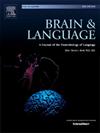The impact of speaker accent on discourse processing: A frequency investigation
IF 2.3
2区 心理学
Q1 AUDIOLOGY & SPEECH-LANGUAGE PATHOLOGY
引用次数: 0
Abstract
Previous studies indicate differences in native and foreign speech processing (Lev-Ari, 2018), with mixed evidence for differences between dialectal and foreign accent processing (Adank et al., 2009, Floccia et al., 2006, Floccia et al., 2009, Girard et al., 2008). Two theories have been proposed: The Perceptual Distance Hypothesis suggests that dialectal accent processing is an attenuated version of foreign accent processing (Clarke & Garrett, 2004), while the Different Processes Hypothesis argues that foreign and dialectal accents are processed via distinct mechanisms (Floccia, Butler, Girard, & Goslin, 2009). A recent single-word ERP study suggested flexibility in these mechanisms (Thomas, Martin, & Caffarra, 2022). The present study deepens this investigation by investigating differences in native, dialectal, and foreign accent processing across frequency bands during extended speech. Electroencephalographic data was recorded from 30 participants who listened to dialogues of approximately six minutes spoken in native, dialectal and foreign accents. Power spectral density estimation (1–35 Hz) was performed. Linear mixed models were done in frequency windows of particular relevance to discourse processing. Frequency bands associated with phoneme [gamma], syllable [theta], and prosody [delta] were considered along with those of general cognitive mechanisms [alpha and beta]. Results show power differences in the Gamma frequency range. While in higher frequency ranges foreign accent processing is differentiated from power amplitudes of native and dialectal accent processing, in low frequencies we do not see any accent-related power amplitude modulations. This suggests that there may be a difference in phoneme processing for native accent types and foreign accent, while we speculate that top-down mechanisms during discourse processing may mitigate the effects observed with short units of speech.
说话者重音对语篇加工的影响:频率调查。
先前的研究表明,母语和外语语音处理存在差异(Lev-Ari, 2018),而方言和外国口音处理存在差异的证据并不一致(Adank, Evans, Stuart-Smith, & Scott, 2009;絮团等,2006,2009;吉拉德,弗洛西亚,戈斯林,2008)。目前提出了两种理论:知觉距离假说认为方言口音加工是外国口音加工的弱化版本(Clarke & Garrett, 2004),而不同过程假说认为外国口音和方言口音是通过不同的机制加工的(cia, Butler, Girard, & Goslin, 2009)。最近的一项单字ERP研究表明,这些机制具有灵活性(Thomas, Martin, & Caffarra, 2022)。本研究通过对扩展言语中不同频带的本地口音、方言口音和外国口音加工的差异进行了深入的研究。研究人员记录了30名参与者的脑电图数据,他们听了大约6分钟的母语、方言和外国口音对话。进行功率谱密度估计(1 ~ 35 Hz)。线性混合模型是在与话语处理特别相关的频率窗口中完成的。与音素[γ]、音节[θ]和韵律[δ]相关的频带与一般认知机制[α和β]一起被考虑。结果显示了伽马频率范围内的功率差异。虽然在较高的频率范围内,外国口音处理与本地口音和方言口音处理的功率幅度有所区别,但在低频范围内,我们没有看到任何与口音相关的功率幅度调制。这表明,本地口音和外国口音的音素加工可能存在差异,而我们推测,话语加工过程中的自上而下机制可能会减轻在短语音单位中观察到的影响。
本文章由计算机程序翻译,如有差异,请以英文原文为准。
求助全文
约1分钟内获得全文
求助全文
来源期刊

Brain and Language
医学-神经科学
CiteScore
4.50
自引率
8.00%
发文量
82
审稿时长
20.5 weeks
期刊介绍:
An interdisciplinary journal, Brain and Language publishes articles that elucidate the complex relationships among language, brain, and behavior. The journal covers the large variety of modern techniques in cognitive neuroscience, including functional and structural brain imaging, electrophysiology, cellular and molecular neurobiology, genetics, lesion-based approaches, and computational modeling. All articles must relate to human language and be relevant to the understanding of its neurobiological and neurocognitive bases. Published articles in the journal are expected to have significant theoretical novelty and/or practical implications, and use perspectives and methods from psychology, linguistics, and neuroscience along with brain data and brain measures.
 求助内容:
求助内容: 应助结果提醒方式:
应助结果提醒方式:


